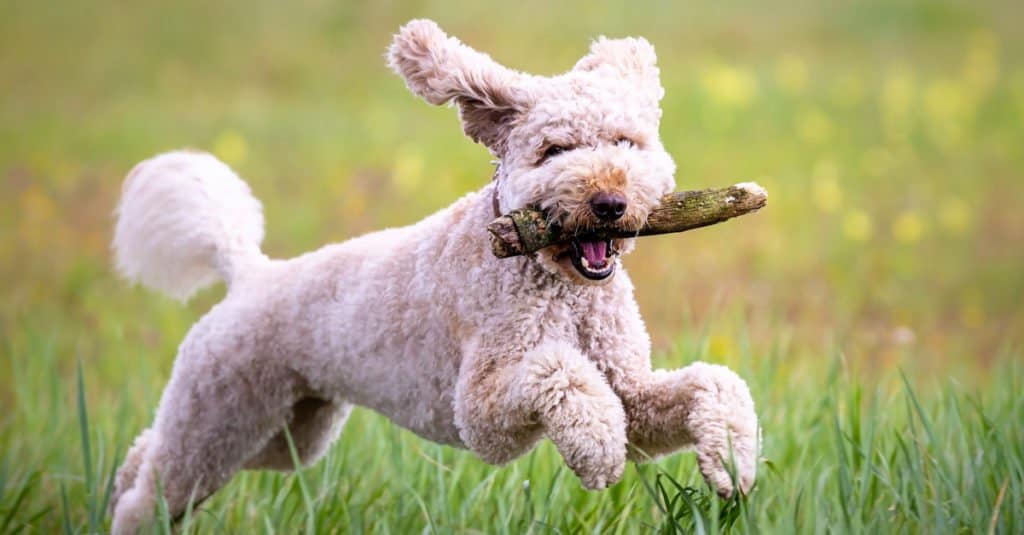Labradoodles are known for their fluffy coats, sweet personalities, and quick wits. But just how smart are they?
Labradoodles typically pick up new cues in just a handful of tries and tend to obey around 95% of the time. They have great working intelligence and also have good instincts, problem-solving abilities, and emotional intelligence.
In this article, we’ll explore Labradoodles’ intelligence and capabilities, as well as how to provide mental enrichment for these smart pups.
Exploring the Intelligence of Labradoodles

Labradoodles rank in the top tier when it comes to working intelligence, which is the type of dog intelligence that’s easiest to measure.
©Flyby Photography/Shutterstock.com
When you adopt a mixed breed dog, their traits can be pretty unpredictable. An example of this is seen in Labradoodle coats.
However, there is less variance in their intelligence. This is because this crossbreed is a mix of two of the smartest dog breeds!
Poodles rank at number two for working intelligence in dogs, topped only by Border Collies. Labradors rank a bit lower at number seven, but both are in the top ten.
They’re considered “top tier” working dogs. As Business Insider explains, this means they need less than five repetitions to learn a new cue. They also listen more than 95% of the time.
There are also other forms of dog intelligence, including problem-solving, instinctive intelligence, and emotional intelligence.
Labradoodles tend to be excellent problem-solvers and have strong retrieving instincts. They’re likely to be good hunters, swimmers, and communicators. Both Poodles and Labs are empathetic dogs often trained for service work.
The Cognitive Capabilities of Labradoodles: Understanding Their Problem-Solving Skills and Brain Size

Labradoodles are great at problem-solving and it can be difficult to find puzzle toys that are challenging enough for them!
©iStock.com/EvgeniiAnd
According to a study on yawning in dogs, Poodles have a median brain size of around 92 grams, and Labrador brains weigh around 102 grams. This study did have a small sample size, but still gives us an idea of how large these breeds’ brains tend to be.
Part of the size difference in the breeds’ brains can be attributed to their body size. You can likely expect your Labradoodle to fall in the middle of the spectrum depending on how big they are.
It’s important to note, though, that brain size doesn’t actually determine how smart a dog is.
When it comes to problem-solving, most Labradoodles can problem-solve independently. You’ll see this if you give your dog a puzzle toy, which they’ll likely solve within minutes, and you might notice it in day-to-day life as well. They may easily guess what you want during training sessions, find their way into the food cabinet to give themselves a second dinner, or smoothly navigate their way around obstacles in their path.
Labradoodles’ Learning Aptitude: How Quick and Adaptive Are They?

Labradoodles pick up on new cues quicker than most dogs.
©Lynxs Photography/Shutterstock.com
Most Labradoodles are going to learn much faster than other dogs. They rank within the top ten for intelligence since both Labs and Poodles are so smart.
Some pups will catch on to a new game or cue the moment they’re shown what to do. This is amazing to watch if you haven’t had a dog so smart before, but it also presents some challenges.
You’ll need to keep things interesting to keep them coming back for more, whether you’re training, playing, or providing mental enrichment.
Intelligence Ranking: Where Do Labradoodles Stand Among Other Breeds?

They rank in the top ten for canine working intelligence.
©KariDesign/Shutterstock.com
Since Labradoodles are mutts, they aren’t included in breed rankings. To figure out where they rank, we need to look at the parent breeds: Labrador Retrievers and Standard Poodles.
Poodles are the second smartest dog breed and Labradors rank at number seven. This means that your Labradoodle will be smarter than most dogs out there, at least when it comes to working intelligence.
They will learn new cues extremely quickly and will likely pick up on things without training as well. For instance, your Labradoodle might learn certain words just by listening to your conversations.
It’s important to note that every dog is different, especially when we begin talking about mixed-breed pups. You might find that your Labradoodle has a more difficult time learning than others or that your dog of a “less intelligent” breed is actually smarter than them!
Unlocking Labradoodles’ Intelligence Potential: Training Techniques and Mental Stimulation

Labradoodles require daily mental enrichment to prevent boredom and stress.
©Angeline Dobber/Shutterstock.com
Keeping your Labradoodle mentally stimulated can be difficult if you rely on the same activities each time. Imagine doing the same simple puzzle every day–this is how many smart pups feel!
Puzzle toys are great, but these dogs will learn them fast. Buying new ones to keep them occupied would be expensive and potentially wasteful.
So, I recommend opting for more versatile options. These can be inexpensive or even free, such as hiding treats around the house or backyard for your dog to find, teaching them to sniff out their toys, or playing fetch in the backyard or pool.
Here are some ways to provide mental enrichment to your Labradoodle:
Training
Training doesn’t have to stop with the basics. For your Labradoodle, it probably shouldn’t! Learning new cues is engaging, challenging, and tires out your dog’s mind.
There are a variety of things Labradoodles can learn, including tricks that are just for fun like learning the names of toys, useful tasks like finding misplaced items, and dog sports like agility (even if you never actually enter any competitions!).
Daily Walks
Daily walks engage so many of your dog’s senses. They get fresh air and a bit of exercise, but the main purpose is to work their minds.
Sniffing is very engaging for dogs, and just going to a new place and sniffing around can actually make your Labradoodle pretty tired.
While they’re young, you might also pair these walks with socialization, or learning how to behave in a variety of situations. Introducing one new thing on your walk can be a fun challenge even for older pups–just be sure to take it slow and keep things fun! You don’t want to push it so far that walks become a stressful experience.
Games of Fetch
You can play fetch traditionally or toss a toy into the water–this most closely replicates the kind of retrieving Labradors and Poodles were bred for.
There are also ways to both increase the difficulty of fetch, therefore working your dog’s mind more, and to make the game a bit less overstimulating, making it more healthy for dogs who tend to be obsessive.
When playing fetch, it’s important to make sure your dog isn’t getting too hyped up and overexerting themselves. This can be harmful both physically and emotionally since some dogs become obsessive.
Some ways to change up your traditional game of fetch include tossing the ball into tall grass so that your dog has to spend time sniffing for it, or training a “wait” and “release” cue to have your dog wait before chasing the ball. That last one can be too frustrating for some dogs, so always make sure everyone is having fun.
Flirt Poles
Flirt poles are like giant cat toys! They’re gaining popularity as an alternative to fetch since we now know that fetch isn’t healthy for all dogs.
These can be used to satisfy your Labradoodle’s urge to chase and catch prey. Moving the flirt pole in unpredictable ways will work their mind the most, as they’ll have to guess where it’s going next and figure out how to follow.
Nose Work
Nose work simply means having your dog find something using their nose. This could be hidden treats, toys, or even people!
Some dogs need to work up to nose work, but Labradoodles will likely catch on to the concept quickly. Train the cue “find it” first, then you can also add specifics later on. (“Find the ball,” or “come find me!”)
Thank you for reading! If you have feedback on this post, please contact the AZ Animals editorial team.
The photo featured at the top of this post is © Flyby Photography/Shutterstock.com
Ready to discover the top 10 cutest dog breeds in the entire world?
How about the fastest dogs, the largest dogs and those that are -- quite frankly -- just the kindest dogs on the planet? Each day, AZ Animals sends out lists just like this to our thousands of email subscribers. And the best part? It's FREE. Join today by entering your email below.
Thank you for reading! Have some feedback for us? Contact the AZ Animals editorial team.







